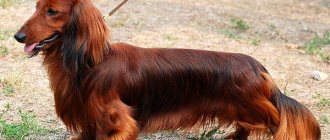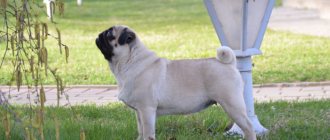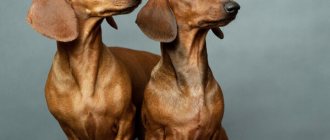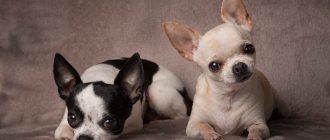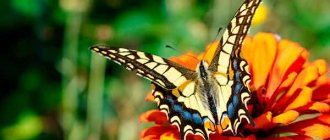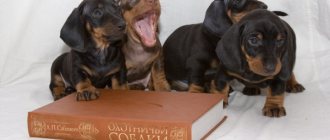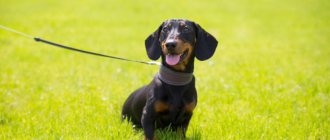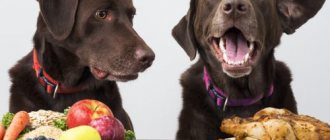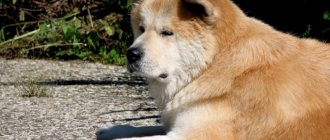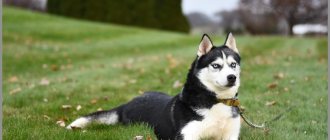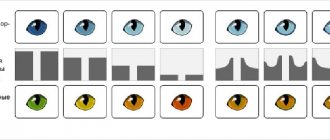Dachshunds make great friends not only for adults, but also for children.
For a dachshund, the place of residence is not important, therefore, it feels comfortable both in an apartment and in a country house.
Initially, the dachshund breed was bred for hunting, as its small stature and excellent sense of smell allowed it to easily track prey and sneak up on it unnoticed.
What color is considered a breed defect?
A dog lover can choose a dachshund with a color according to the breed standard or an unusual color. If you plan to participate in exhibitions, you need the first option. When looking for a dachshund for home and family, it is worth taking a closer look at dogs with rare coat colors, even if they are considered a defect in the breed. The most unusual among them:
- spotted;
- black and brindle;
- isabella;
- double merle;
- cream.
The latter color occurs only in long-haired dachshunds.
Basic rules of care
Caring for the coat of a black dachshund depends on what type it is..
And, if for smooth-haired pets of this breed regular brushing of the coat is sufficient (twice a week, and during shedding - daily), then long-haired and wire-haired dogs will require special care.
IMPORTANT!
Long-haired dachshunds need a little haircut, and wire-haired ones need special trimming.
While learning how to cut a pet with long hair is easy on your own, trimming a wire-haired dachshund is not so easy and requires special skills.
Therefore, at least for the first time, it is better to entrust the groomer to tidy up the dog, rather than try to trim the dog yourself.
In addition to grooming, all dachshunds require daily eye, ear, and teeth care . If necessary, they are cleaned, and if the claws grow too long, they are trimmed using a special nail clipper, but not nail clippers or scissors.
What colors are dachshunds?
For breeding and participation in competitions, individuals with a standard exterior are purchased; animals without strict color requirements are purchased for the home. The table shows dachshund colors that meet these conditions:
| Color | Description |
| Boar | Alternating red and black areas on the coat |
| Chocolate | Brown with a reddish tint |
| Spotted | Spots of different colors on a white background |
| Marble | Brown or black markings on a light background |
| Blue | Looks like blue steel |
| Grey | Steel without silver tint |
| Black and brindle | With dark stripes |
| Brown | Background brown, tan marks |
| Isabella | Coffee with milk color |
| Black | The dachshund looks jet black |
| Double merle | The basic background is white, on which there are marble spots of different shapes and sizes. |
| White | Pure white wool |
| Cream | Looks like a bleached redhead |
| Ginger | Shades from golden to dark orange |
How to choose?
Currently, there are a lot of black dachshunds and, as a result, there are many advertisements for the sale of such puppies. The babies look so touching and adorable that it is very difficult to resist buying one of them.
And yet, I would like to warn potential owners against purchasing a future pet through an advertisement or on the poultry market.
Most of these puppies do not have documents about their origin . It is not even known whether their father and mother are purebred dachshunds, let alone whether they were rejected from breeding due to any shortcomings.
CAREFULLY!
You need to purchase a black dachshund through a kennel club or from a reliable kennel that has proven itself well.
Even if we are talking about buying just a pet, it is better to buy a pet-class pet, but with documents, than without any metrics at all.
When choosing a baby, you need to pay special attention to its exterior, including the intensity and contrast of the tan.
It is very important that the dachshund puppy is friendly and sociable in nature. In addition, the dachshund should look vigorous, healthy and cheerful, and its movements should be free and not constrained.
The black dachshund is one of the most beloved and recognizable dogs in the world . Despite the fact that this coat color is very common among representatives of this breed, black dachshunds do not look boring or monotonous at all.
Due to their unusual appearance, these dogs with a highly elongated body and short legs already seem funny and original.
And the black and tan color of dachshunds is a classic, which is highly valued by many judges at exhibitions, and therefore, it is often the dog with this coat color that becomes the champion of the breed.
Popular colors of dachshunds
All popular dachshund colors are divided into three groups:
- Single-color - an even tone over the entire surface; according to the standard, red, red, fawn are acceptable, white is not welcome.
- Two-color - against a background of brown or black, tan marks from yellow to red, the border between them is clear.
- Complex - the base color is gray, brown or black, against which there are light spots.
Brown
Brown color has different intensities. It changes from almond to almost black. The light brown dachshund has a coffee and tan background. In most cases it is contrasting and bright. If the tan is darkened, the dog appears to be one color, but this is not always the case. Having carefully examined the fur, you can notice several hairs with a reddish tint. In this case, her color is called brown and tan.
Chocolate
When they talk about the chocolate color of dachshunds, they mean a slightly lightened brown with tan marks (red, sand, cream, milk chocolate color). Most often they are located under the tail, above the eyes, on the chest, paws and on the muzzle. A brown and tan dog has brown claws and nose, and gray, brown or blue eyes.
Beige
This coloration is found in long-haired dachshunds. It has an apricot, yellowish tint and looks white or pale red. In light-colored dachshunds, it is not difficult to detect tan from lightened areas on the eyebrows or paws; black hairs on the back or in the ears are acceptable. The claws and nose are charcoal or brown.
Black and Tan
The classic color option for the smooth-haired dachshund is black and tan. Reddish-brown markings are clearly visible against the intense charcoal background. According to the standard, the presence of a small light spot on the chest is acceptable. If it is large, this is a drawback; the individual is not allowed for breeding; it is considered a black and white dachshund.
White
White is not included in the standard, especially when the dachshund is an albino. The peculiarity is determined by light pupils, the absence of any pigmentation of the coat, and a red or slightly bluish iris.
In ordinary white dachshunds, the white-red coat has become very light and its brightness has weakened. Visually, the dog appears with a white chest, head, legs, body and tail. In this case, the nose, lips, and rims of the eyes are brown or black.
Ginger
One of the most common colors corresponds to the breed standard. Shades are possible - from golden to red-red. Taxis with black hairs located on the surface of the body with varying intensity and density are most valued. This type of redhead is not a deviation from the standard.
Yellow
The yellow color of dachshunds resembles beige, but the pigment of the coat is more saturated. Shades can be either soft golden or close to lemon.
brindle
Brindle-colored dachshunds are born very rarely. Their name speaks for itself - there are dark stripes on a fawn or red field. The dogs have an unusual and mysterious appearance. The coloring is considered a breeding defect; the FCI is not recognized.
Boar
This coloring is also found in other breeds, but is called agouti. Externally, the hair of a boar-colored dachshund resembles stubble due to the fact that the pigment in the hairs alternates and forms brown and black stripes along the entire length. The overall impression of a color largely depends on its saturation and brightness. The color is officially recognized as a standard only for smooth-haired dachshunds; for the rest it is a defect of the breed.
Gray (ash)
According to the standard, uniform gray coloring of taxis is not provided, although there are individuals with a steely ash color without a blue tint. More often, puppies are born with beige, cream, or light brown tan, which is so close in tone to the background that it merges with it. The base color is ashen, the claws, nose and eyes are gray.
Marble
Dogs with this color are the most unusual, their puppies are highly valued. The background is red or black. Light gray spots of various sizes and shapes are randomly located along it. The color is considered most correct if the markings of all colors are distributed evenly over the entire surface of the coat. The pattern changes with age - the number of spots decreases, their brightness decreases. Large white markings are acceptable. The eyes of marbled taxis are blue or multi-colored, the nose and claws are brown.
Pink
The color of red dachshunds is called fawn color. A rich, monochromatic color is rare, so it is in demand among dog breeders. The standard describes it as red or tan. The presence of dark hairs, small white spots and light hairs is acceptable. Nose and claws are bright brown or black.
Blue
Dachshunds with blue fur have a steel or graphite-colored background with a slight bluish tint. The coloring is unusual and striking, with tan often present, which when heavily shaded gives the impression of a pure blue dog. It is not recognized as a standard.
Tricolor
Three-color coloring, or tricolor, suggests the presence of red, black and white. Most often, multi-colored dachshunds have the darkest color as their base color. The dog is perceived as charcoal, only its paws and chest are white, and red tan marks are located on the eyebrows, muzzle and paws.
The colored dachshund can be uniformly colored, with large white, tan and black markings throughout the body. The head is brown with small white spots.
Redheads have black fur only on the back, and white fur on the belly, chest and paws.
Life expectancy and health
On average, black dachshunds live 12-13 years .
Typically, they rarely get sick, but due to their highly elongated body shape, they can be prone to spinal diseases and injuries.
In addition, these dogs may have other diseases, such as:
- Epilepsy.
- Eye diseases.
- Inflammation of the ears.
- Obesity.
- Hernia.
Dachshund puppies may also have the so-called “swimmer’s syndrome” - chest deformation . In severe cases, puppies suffering from this pathology cannot rise to their paws or walk at all.
Fortunately, the risk of acquiring a baby with this disease is minimal: after all, “swimmer’s syndrome”, as a rule, is clearly visible already at the age of 1 month.
Non-standard colors in dachshunds
In addition to dogs of popular colors, there are dachshunds of rare colors. These are exotic colors that are not standard. The most famous among them are double merle, isabella, sable, spotted.
Double merle
Double merle (or double merle) color carriers are born from merle-colored parents. In contrast, dachshunds have a white color on their fur. Dogs' eyes are blue or multi-colored (heterochromia). Very often puppies have problems with vision, hearing, and low immunity. According to the requirements of the FCI, mating two marbled individuals is unacceptable not only because of problems with the health of the offspring, but also because of the high probability of giving birth to albinos.
Isabella
To get a puppy with Isabella color, it is necessary that the parents have brown and blue genes in their DNA. The result is a dwarf chocolate dachshund with a light or café-au-lait tone. Babies have weak immunity and a number of hereditary diseases due to genetic problems.
Sable
The color is very rare, so sable is often confused with red. Occurs in long-haired species. The peculiarity is the uneven color of the hairs - at the very end they are dark, at the base they are light. Outwardly it looks like a brown or charcoal coating. Black fur on the ears, chest, along the spine, sides and muzzle. Since puppies pre-color, sable color is only accurately determined at the age of six months and older. The nose and claws are black.
Spotted
Another name for the spotted color is piebold. This is one of the new areas of dog breeding. Assumes the usual color (red, brown, blue) with the obligatory presence of white. The total area of dark spots should be less than the amount of white. This color existed even among the founders of the breed, remained in the DNA memory and manifested itself in certain combinations. In Germany it is not considered a standard, but in America, England and Canada it is recognized, classified as rare, and highly valued.
Origin story and what it looks like in the photo
Black dachshunds are one of the oldest dog breeds in the world . Even in Ancient Egypt there were hunting dogs with short legs, an elongated body and a long saber-shaped tail.
They were distinguished from modern dachshunds by a slightly different shape of the head and muzzle, and also by the fact that Egyptian dogs had erect rather than drooping ears.
Real dachshunds were bred in the Middle Ages, on the territory of modern Germany . According to some sources, squat, fold-eared dachshund dogs have been found there since the 15th century.
But, if you believe official documents, then dachshunds as a breed appeared later: in the 18th century.
And they already had the same features as modern dogs, with the exception that the first dachshunds were distinguished by a slightly more massive structure and at the same time were longer-legged.
The black color of dachshunds has long been considered the most preferable color for working dogs..
In any case, in most paintings of the 18th and 19th centuries with images of hunters and their dogs, you can see black dachshunds, although along with them there were originally dogs of other colors.
Types by appearance
Based on external features, they are divided into types:
Note!
Nicknames for dogs for boys - easy, rare and most beautiful names for dogs in alphabetical order
Nicknames for girls' dogs - a list of beautiful, funny, unusual nicknames for large and small dog breeds
Maltipoo dog - everything about the dog from A to Z. Photos, description of the breed, character, maintenance features, prices, reviews
Standard – widespread. Body weight - about 9 kg. Chest circumference - 35 cm or more.
Dwarf. Body weight – up to 7 kg. Bust circumference – 30-35 cm.
Rabbit. Body weight – up to 4 kg. Chest circumference – up to 30 cm.
Height at withers – from 12 cm to 30 cm, respectively. Belonging to any of the species is judged by chest girth.
Content
Small dachshunds live wonderfully in a city apartment. But in this case, they will need daily, rather long walks. They are completely unpretentious to living conditions and have an easy-going character. The little ones feel great when traveling and do not resist transportation.
In a private home, the dachshund should live indoors. Leaving it in an enclosure is very dangerous: the dog is not very well adapted to the cold and cannot tolerate lack of attention from its owners.
Character
This is a very kind, smart dog. That's why single people and families with children start it. But her specialty is that she is a hunting dog. Even the mini varieties were bred not for the sofa, but for hunting rabbits. Due to this origin, adult dachshunds have several specific character traits.
- Independence is explained by the fact that a burrowing dog must hunt the animal itself and make decisions when the person is not around. Therefore, adult pets are quite capricious. They understand everything, know the commands, but do not always follow them.
- Curiosity is one of the main qualities of dachshunds. They examine everything, sniff every new object that appears in the house.
- Very active and playful, these pets are always ready to run, play with other animals or with their owner. Despite their short legs, dachshunds move quickly and do not like to sit still.
- They become very attached to their owner, love him, constantly showing him off. They require affection and lick. These are gentle, affectionate pets who love to relax on the couch.
- These little dogs are very adventurous and fearless. They can attack dogs larger than themselves and bark at a cat for hours. When the hunting instinct awakens in them, they do not pay attention to anything around them.
- An adult dog is amazingly smart. These pets are smart, inventive and artistic. In communication, only authority is recognized. If the owner even once allows weakness, especially with a puppy, the dog will not obey.
- Dachshunds behave differently with children. They usually do not listen to younger family members, not considering them as authority. Sometimes they can even show aggression. But often the pet becomes attached to the baby and then protects him.
Education and training
You need to raise a puppy from the first days of his appearance in the house. It will be impossible to retrain an adult dog later. The pet will obey if the owner managed to establish contact with it. Representatives of this breed are easy to train, but do not always follow commands. Therefore, it is not recommended for indecisive and inexperienced people to have such a dog.
A small puppy must first be taught the rules of behavior: accustomed to a place, a toilet, behavior in the house and on a walk. During training, reward your pet for correctly following commands. You cannot physically punish a dachshund; it will stop trusting its owner.
